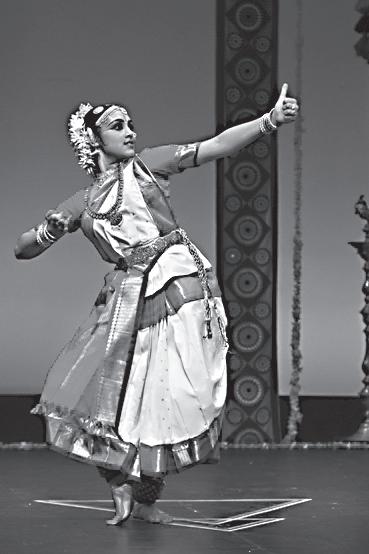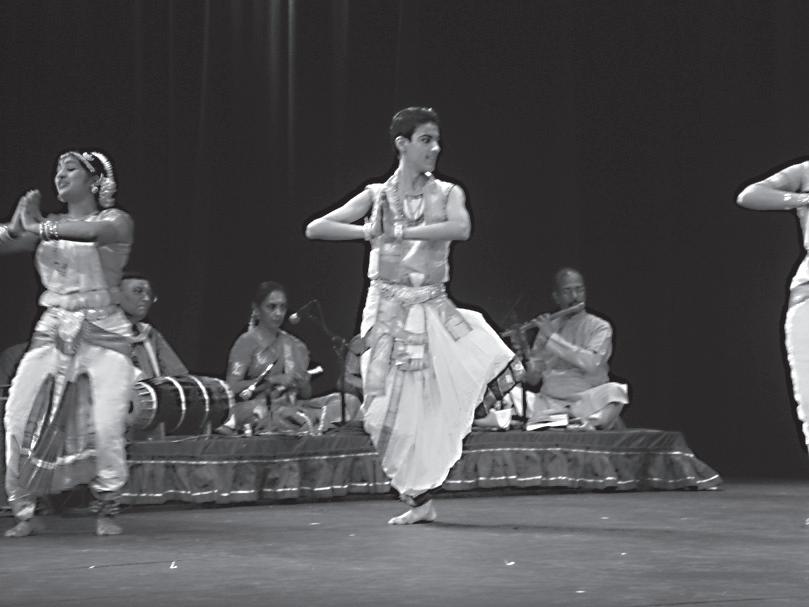
5 minute read
The classical scene
from 2009-08 Melbourne
by Indian Link
of that school, presented a flawless solo recital.
Ramya began with the invocatory Pushpanjali followed by a dance devoted to Lord Ganesha in Naatai with confidence, and did not put one step wrong. the Madurai-Muralidaran choreographed Maruti Kavuthuvam in the first half of the evening was a delightful item which allowed Ramya to portray Hanuman –often a role which tests the mettle of even accomplished dancers. This was followed by a not-so-common varnam in Latangi in praise of Lord Shiva. The padams and keertanas that brought up the second half of the programme were all executed well, culminating in the lively Brindavani tillana, all choreographed by Smt Rajendran. Smt Radha Badri from Chennai provided charming vocal support; Smt Narmatha Ravichandhira’s violin and Ramani Thiagarajan’s flute, with Sri Ravichandhira’s mrudangam made up a lively orchestra. •
Nandini Nagasundaram’s solo recital
The Nadanalaya school performed a series of Krishna’s leelas - all based on the compositions of the great 20th century Tamil poet Subramania Bharati. In it, Krishna was depicted as an adorable baby, a boy playing childish pranks, a youth and a cowherd – as well as the Supreme God of the Bhagawad Gita. The choreography and presentation were imaginative and relief to providing education for blind, tribal and underprivileged people; from promoting the study of Vedas to other scriptures. Its pontiff, Sri Sri Chinna Jeeyar Swami has inspired thousands of people over the years to build an organisation that works for the community at many levels. On June 21, Jet australia’s Melbourne chapter organized a gala Indian entertainment and dinner in order to raise funds for charities –primarily in Australia. with her command of the three “n”s: nritta, nritya and natya.
The items were well thought out and represented a broad spectrum of themes: from the navasandhi kavuthuvam to the jatiswarm, padam and tillana. By far the most demanding and longest item was the Swati Tirunal kriti “Bhavayami” in Ragamalika that she presented instead of a varnam as per tradition. It was indeed arranged like a varnam, with jatis and teermanams interwoven into the composition. In it Gayathri brought to life the whole Ramayana playing the character of Rama one moment, Sita the next, and Hanuman yet another. Her story telling skills and abhinaya were of the highest order.
In Bharata Natyam, connoisseurs look for ‘azhuttam’ in a dancer: they are the razor sharp movements of the limbs and the precision and speed of the adavus. Gayathri is one of a minority of dancers in Melbourne who displays that azhuttam in good measure.
Gayathri was fortunate to have Vijay Prakash, a cousin, lending vocal support for the event. Vijay Prakash is a rising star in Bollywood and is a much sought after singer in the tinsel city after the success of his music in Cheeni Kum and Slumdog Millionnaire – having been one of the voices behind the hit song Jai Ho!
Dr Chandrabhanu was supported on the Nattuvangam by Ambika Docherty and Veshnu, and Sri Balasri Rasiah’s mrudangam was spot on. Sri Murali Kumar on violin and Sri R Thiagarajan on the flute contributed to an enjoyable musical orchestra. •
Bharatanatyam: Ramya

Cumarasamy’s Arrangetram
raMya CUMaraSaMy’S Arangetram was held on 27 June at the George Wood Performing Arts Centre. She is a student of Smt Shanthy Rajendran’s Nrithakshetra School of dance, and in the true tradition nanDini naGaSUnDaraM’S solo bharatanatyam performance was held at the renaissance Centre. She had begun learning from the eminent guru Smt Tejashree Adige in Pune from a young age, and on her arrival in Melbourne, continued her training under Smt Shanthy Rajendran of Nrithakshetra, moving on later to Smt Radhika Suresh Mahadeva, [a disciple of the illustrious Dhananjayans of Chennai] under whose tutelage she had her arangetram in 2006, in Chennai. having spent most of 2008 in India, and learning dance from the doyen of bharatanatyam – the legendary composer, choreographer and dancer Professor C V Chandrasekar, nandini and her parents wished to present to the Melbourne audience the fruits of the advanced training she had received under that eminent guru. nandini began with a Pushpanjali, followed by a sabdam composed in ragamalika by Prof CVC. The varnam in danyasi on Lord Krishna was a traditional kalakshetra item which she performed flawlessly. Her adavus were polished, graceful and crisp, and bore the hallmarks of her great guru. In every piece, her hard work and the intensive training she must have undergone were evident. having watched Nandini perform in 2006 in Chennai, it was obvious to this reviewer that she had matured as a dancer, and displayed the self-possession, confidence, grace and poise of a professional.
Most of the items that Nandini presented that evening were, therefore, choreographed by Prof Chandrasekar himself, and several of the musical pieces for the dances were also composed by him. Moreover, he had lent his voice for the recorded music for the evening, - not to mention the nattuvangam and solkettu.
• Salangai In Sangamam
SAlAngAi in Sangamam was a dance presentation by three bharatanatyam schools in Melbourne: Shanthy Rajendran’s Nrithakshetra school, Narmatha Ravichandira’s Bharata Choodamani school and Meena Elankumaran’s Nadanalaya School.

evocative, and the audience able to follow and enjoy the episodes from Lord Krishna’s life.
Bharata Choodamani school took up the theme of Dasavatara - depicting the 10 avatars of Vishnu in a complex ragamalika presentation - which had been choreographed by the well known Bharatanatyam guru Sri Adyar Lakshman, and rhythmic arrangements by Karaikudi Sri Mani and Sri M Rama and Krishna avatars, understandably, received detail treatment at the hands of the choreographer, and the students
When the City of Monash – especially councillor Paul Klisaris – as well the former Mayor Tom Morrissey, saw the stellar work Melbourne, they helped get the Clayton Hall for free, and Mr Tom Morrisey also graced the occasion. that evening, JET presented a cheque of over a thousand dollars each to the epilepsy oundation, the Cancer Council and BestChance Child Family Care Foundation. Over 400 guests attended the event, which included Ms Inga Peulich, State Member for the South Eastern Metropolitan Region and Shadow Secretary for Education and Community. Three visitors from Sydney came specially to be present for the event. A souvenir was also released to mark the occasion, which was followed by a multimedia presentation of the schools and charity work that the organization helps support in india.
The entertainment segment began with a laya Vinyasam or Percussion Ensemble, presented by the students of Sruthilaya Kendra, with a special guest concert by the well known flute maestro Sri beautifully depicted and enacted various well known episodes from the Ramayana [Sita Swayamvara, Tataka vadam, building of the bridge by the vanara sena to Lanka, and the final battle with Ravana] and Lord Krishna’s life [his infanthood, the Kaliya nardana episode and the lifting of the Govardana mountain].
The senior students of Nrithakshetra presented a very impressive and demanding Mallari, a pancha bhootam and a tillana. Only dancers as accomplished as those from nrithakshetra could make something relatively unexciting like the Pancha bhuta – [the five elements of nature] come alive and make it this beautiful and visually engaging. Choreographed to the music of Madurai Muralidaran, they brought out in dance the 5 elements with a message that stressed the balance between the elements and the need for environmental protection. Their choice of the popular Swati Tirunal tillana in Suddha Danashri was a fitting finale to an evening of superlative dance.
JETting for charity
a fLeDGLinG indian organisation – Jeeyar education trust or Jet – has been involved in a range of charities in India from disaster a skit by the Prajna students, Bollywood dance items and finally, music by the Raga Lahari Music club - all while the guests enjoyed a sumptuous dinner.
•
Mummoorthigal Festival
the annUaL Mummoorthigal Festival was organised by the Academy of Indian Music at the Kel Watson Centre in June this year. The two-day event focuses on the compositions of the three great composers of Carnatic music, Dikshitar, Shyama Shastri and Tyagaraja. Apart from two rare occasions, the festival has been organised by the Academy over the past 20 years entirely through its own effort, without it being subsidised once by the State, Federal or Local Government. Organising something on this scale is no mean feat, and the Academy of Indian Music – and its students – must be congratulated for this marathon effort.
On this occasion, ravichandhira traced the 25 year- development of the Festival in Melbourne and in australia – beginning with the support of Marni Selvendra, Dr Sampath (Canberra) and the migration
Continued on page 20









